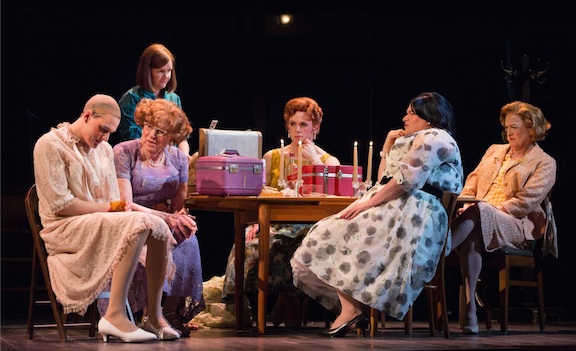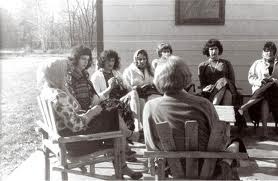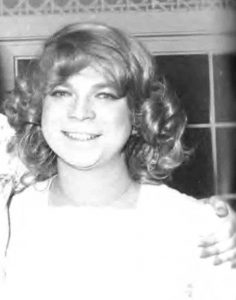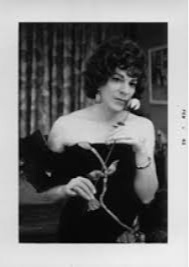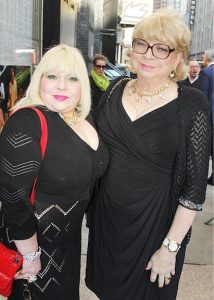The Historical Roots of “Casa Valentina”
Dallas Denny has shared this article from her Chrysalis website.
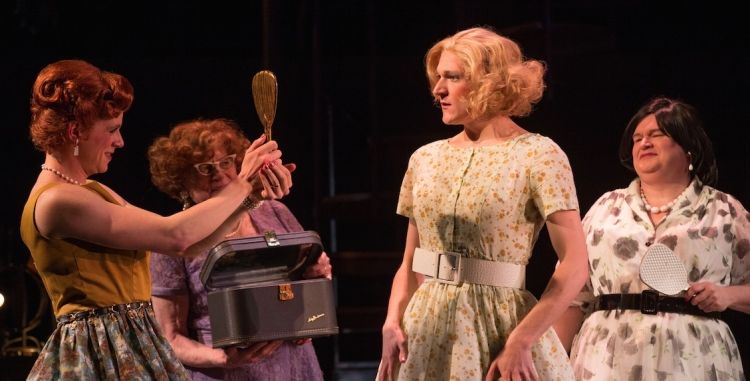 Casa Valentina. A play by Harvey Fierstein. Directed by Joe Mantello.
Casa Valentina. A play by Harvey Fierstein. Directed by Joe Mantello.
Samuel J. Friedman Theatre, 261 W. 47th Street, NY, NY
In the early 1960s small groups of crossdressers were meeting clandestinely on the East and West coasts of the United States. In Los Angeles they gathered in the living room of early activist Virginia Prince. In New York they drove to the Catskills with the trunks of their cars filled with female attire. Their destination: The Chevalier d’Eon Resort, which would soon be renamed Casa Susanna.
Casa Susanna was a semi-dilapidated resort complex in Hunter, New York; it was purchased by Marie Valenti, who owned a wig shop in Manhattan and was the second wife of a Cuban-American crossdresser named — you guessed it — Susanna. Susanna’s male name was Tito. Guests would arrive in suits and ties but would soon change into cocktail dresses and sweater sets to begin a weekend as the women most of them wished they were.
One of those crossdressers was a young person who called herself Andrea Susan. Thanks to an older group member named Dick, who bought her an enlarger and photo developing equipment, she was the group’s official photographer. Andrea took formal and informal pictures of the attendees, singly and in groups, and developed them at her home in Westchester County.
Because they provided instant gratification and didn’t require frightened crossdressers to rely on professional developers who might out them or call the police, Polaroid’s instant cameras were popular with Casa Susanna’s temporary residents. Andrea was even more popular. Her photographs were of far higher quality than Polaroids and besides, she was family. Unlike the clerk at the corner drugstore, she could be trusted with images that, if seen by the wrong people, could destroy lives.
Andrea dutifully turned over the negatives to her mentor — but when he married a disapproving movie star he threw his prints and negatives into his garbage can. Someone obviously picked them up, for they surfaced decades later in a bin at a Manhattan flea market, When Robert Swope, “a gentle punk rocker turned furniture dealer,” came across more than one hundred images of women who appeared to have male bodies, he was transfixed.
He knew nothing about their stories, or Casa Susanna, beyond the obvious: here was a group of men dressed as women, beautiful and homely, posting with gravity, happiness, and in some cases outright joy. They were playing cards, eating dinner, having a laugh. They didn’t look campy, like drag queens vamping it up as Diana Ross or Cher; they looked like small-town parishioners, like the lady next door, or your aunt in Connecticut (Green, 2006).
Swope bought every photo he could find.
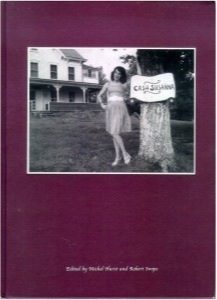 Without understanding exactly what had been happening up in the Catskills, Swope and partner Michel Hurst assembled the images into a book named Casa Susanna, which was published in 2005 by Powerhouse. Penelope Green’s September 7, 2006 review in the The New York Times brought widespread attention to the book.
Without understanding exactly what had been happening up in the Catskills, Swope and partner Michel Hurst assembled the images into a book named Casa Susanna, which was published in 2005 by Powerhouse. Penelope Green’s September 7, 2006 review in the The New York Times brought widespread attention to the book.
In a March 11 interview on WQXR Radio, Tony Award Winning playwright and actor Harvey Fierstein told interviewer Elliot Forrest he had been aware of Casa Susanna as a child, when his family vacationed in the Catskills—but he was more interested in the nudist colony that was just across the street than in the men who dressed as women. However, when producer Colin Callender urged Fierstein to write a play about Casa Susanna, he agreed to look into it—and the more he learned, the more interested he became.
The result was Fierstein’s Casa Valentina, which is now playing on Broadway at the Samuel J. Friedman Theatre. Directed by Joe Mantello, its cast consists of actors Reed Birney, John Cullum, Gabriel Ebert, Lisa Emery, Tom McGowan, Patrick Page, Larry Pine, Nick Restrate, and Mare Winningham. Casa Valentina has been nominated for best play of the year for the Tony Awards.
Reviewers have tended to call Fierstein’s play preachy, but have been positive about the performances by the cast. I saw Casa Valentina on April 30th. Here’s my review, of sorts, if you can find it, buried as it is amongst my discussion of the real-life events that somehow turned into a Broadway show.
I have to call a spoiler warning here. I’ll be discussing the crisis at the center of the play, and that will of necessity mean revealing the plot to some extent. So ready now, let’s all say it together: SPOILER WARNING!
Casa Valentina is set in 1962 and is based upon actual events. The character Charlotte (who is clearly based upon the late Virginia Prince) has come to the resort with a purpose — she wants to form a national organization for crossdressers, and she has a definite idea about who should and should not be allowed to participate.
In actuality, Virginia Prince did come to Casa Susanna in 1962, and organizing was in fact on her mind. In a photo in Casa Susanna, she can be seen sitting at a dining table with the Catskills’ finest (the photo was taken and developed by Andrea, who told me a hat had been passed at a previous get-together to finance Virginia’s trip). Virginia was hoping to turn her Los Angeles-based Hose and Heels Club into a national organization called Full Personality Expression; to do that, she needed the support of crossdressers on the East Coast — in other words, the crew at Casa Susanna.
In 1962 Virginia was in her third year as publisher of Transvestia, her nationally-circulated magazine for crossdressers. It was, in fact, networking by crossdressers associated with the magazine which had led to the formation of Casa Susanna and the Hose and Heels Club. She was asking much of the closeted crossdressing men of Casa Susanna: shed your anonymity, she told them. Take some risk. Let’s take our identities and our demands for acceptance public. For the closted ladies at Casa Susanna, it was a scary proposition.
Virginia (as does Charlotte, in the play) got what she wanted, but not without cost. The price for organization, she told her peers, required the exclusion of homosexual crossdressers and transsexuals from fledgling crossdressing society. After all, says doppleganger Charlotte in Fierstein’s play, “Fifty years from now, when homosexuals are still the back-alley vermin of society, we will be dressing and as normal as smoking cigarettes.” Funny how that worked out.
Virginia’s homophobia was shared by the U.S. Post Office, which was determined to do its part to wipe out what they considered sexual perversion. Postal authorities had recently convicted Virginia of sending obscene materials through the mails. The material under question was erotic in nature — Virginia had a frisky exchange with another crossdresser (in an audio recording I made in the late 1990s, she told me she thought her correspondent was a female; I doubted it then and I doubt it now). For postal inspectors, the letters were a means to an end — the goal was to force Virginia to shut down Transvestia. To her everlasting credit, she refused. It cost her dearly — she was convicted of a felony and sentenced to three years in federal prison (Prince, 1993). Happily, she was not required to serve time. According to Andrea, the incident frightened Susanna so much she pulled advertising for the resort and Marie’s wig shop from Transvestia, maintaining she had no idea about the content or the nature of the readership. Valentina was never, so far as Andrea knew, investigated by the post office. I was prepared to think the postal service’s investigation of Valentina in Fierstein’s play was a plot contrivance, but then I discovered it wasn’t:
In 1961 Tito was summoned by postal officials. Two of her correspondents had been charged with mailing obscene materials, and Susanna’s name had come up. Tito pleaded respectability and denounced the obscenities. (Susanna Valenti, A Gender Variance Who’s Who).
Considering how gay men were reviled in American society in those pre-Stonewall years, considering that most of the crossdressers at the Hose and Heels Club and Casa Susanna (and Virginia as well) identified as heterosexual, and considering Virginia’s persecution at the hands of postal officials, it made a sort of sense that she wished to make it clear to the American public that crossdressing did not equal homosexuality.
I love this quote by Mr. Fierstein:
The truth is I’ve worked very hard to make sure I’m expressing it right, and I don’t come to conclusions in the play. Because I think it’s bulls–t to come to conclusions when I know the truth isn’t the same for any two people.
These men believed — remember we’re talking 1962, before Stonewall, before liberation — hat no decent, God-fearing society would every accept homosexuals as normal. So, in the play Charlotte is speaking politically. The feeling was, we kill two birds with one stone by banning homosexuals: We get our wives to understand that we don’t want to have sex with each other (which, like I said was not true of everyone) and we tell society there’s no reason to be frightened of us, because we’re not looking at your dicks.
There was somebody online, a gay man, who actually said I wrote an anti-gay play. Like, “We all know that heterosexuals hate us, why does Harvey have to rub our faces in it?” But, for the time, I believe Charlotte was absolutely right. I think her choice was wrong for many reasons, but I could see why she made that conclusion, can’t you? (Kumar, 2014)
Unfortunately, Virginia was successful in forcing her homophobia onto the infantile crossdressing movement. It would be an unfortunate legacy.
And how did Virginia bend other crossdressers to her will? Not, in all likelihood, with blackmail, as Charlotte does in Casa Valentina. Rather, she used persuasion, coercion, peer pressure, banishment, and her often-vicious tongue to get her way. The result was the same, so I can hardly fault Fierstein for taking the literary license.
There was no shortage of homophobia amongst the crossdressers of the 1960s, but many were in fact gay or bisexual (especially when dressed) and many who weren’t saw no good coming from Virginia’s harsh stifling of dissenting voices. Outcasts and dropouts from FPE started rival publications (like Siobhan Donovan’s Turnabout) and support groups and at least one book — Darryl Raynor’s 1968 A Year Among the Girls — is devoted to Virginia’s autocratic leadership style and its effect upon FPE members.
When dogma becomes policy, it tends to not go away. Virginia’s no-transsexuals, no-gays, no-fetishists platform, once inculcated, persisted. The Society for the Second Self, FPE’s successor organization, continues to this day to maintain Virginia’s exclusionary membership criteria. It’s a policy that kept me from my own community for a decade, and it’s a policy that doesn’t address the needs of the organization’s members, who learn to hide their same-sex attractions and their tendencies toward transsexualism. It persists even when the underlying rationale no longer makes sense. After all, more than 50 years have passed. Gay men and lesbians are no longer considered “back-alley vermin;” they have become far more normalized in society than crossdressers.
So — what became of the people of Casa Susanna? Some, including Tito Valenti’s wife Marie, died prematurely. Others lived long lives, crossdressing in secret until the end. Some eventually became open about their crossdressing. Felicity Chandel, for instance, fought her conviction for crossdressing in public all the way to the U.S. Supreme Court. Yet others, including Katherine Cummings, came to identify as transsexual, transitioned gender roles, and had sex reassignment surgery.
And what of Susanna herself? According to her bio on A Gender Variance Who’s Who, in 1968 she made the decision to live full time as a woman. She came out to readers of Transvestia in October, 1969 and continued to write for the magazine through early 1970. After that she vanishes from public view.
I didn’t find Fierstein’s play at all preachy. I suspect some who have called it so just weren’t prepared for a play that deals with the political ramifications of crossdressing in early 1960s America.
When I had lunch with Andrea Susan a couple of weeks ago, we went through my copy of Casa Susanna and I made notes indicating which photos she took and which she developed. I’ve not counted, but I estimate about three-quarters of the photos are hers.
Andrea’s uncredited photos tell a remarkable tale of secret desires and societal tensions in mid-Twentieth Century America. Robert Swope and Michel Hurst had no way of sourcing the images they purchased, and Harvey Fierstein, when writing Casa Valentina, had never heard of her — but to his credit, when Andrea’s daughter Jacqueline gave him a call, Fierstein sent a pair of tickets to the premiere. There he met the person whose work informed his own. How cool is that?
Works Cited
Brantley, Ben. (2014, 23 April). A place to slip into something comfortable: Casa Valentina, a new play by Harvey Fierstein. The New York Times. Read it here.
Cummings, Katherine. (2008). Katherine’s diary (Updated edition). BookSurge Publishing.
Green, Penelope. (2006, 7 September). A safe house for the girl within. The New York Times. Available online here.
Kumar, Naveen. (2014, 24 April). Harvey Fierstein on straight men in stockings and his new Broadway play Casa Valentina: Interview. Read it here.
Prince, Virginia. (1993, Spring). How I became a convicted felon. Chrysalis Quarterly, 1(5), pp. 23-24, 50, 41. This article was first published in 1979 as part of a larger history in Transvestia No. 100. Read the Chrysalis article here.
Raynor, Darryl G. (1968). A year among the girls. Lancer Books.
Swope, Robert, & Hurst, Michel. (2005). Casa Susanna. New York: Powerhouse Books.
Andrea Susan will speak about her time at Casa Susanna this fall at Fantasia Fair.
Category: Transgender Community News, Transgender History, Transgender Opinion


